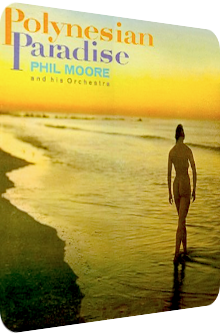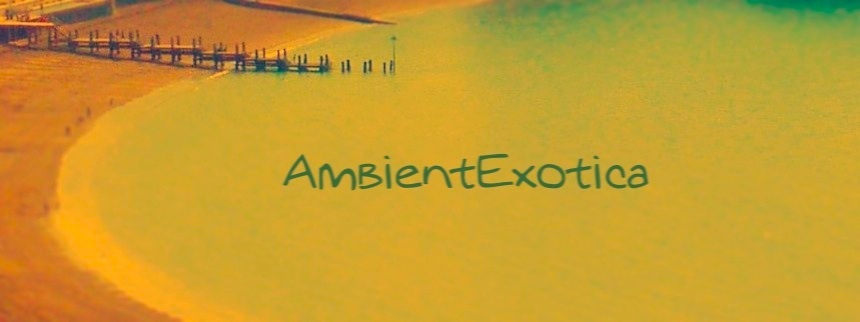
Phil Moore
Polynesian Paradise
1959
Polynesian Paradise by arranger and songwriter Phil Moore (1918–1987) is one of the very best percussion-fueled symphonic Exotica releases of all times. Released in 1959 on Strand Records at the peak of the Exotica craze, its 12 compositions, among them five unique cuts specifically written by Phil Moore for this album, are enormously enchanting, dense, soothing, varied, simply paradisiac. With a mixed choir on board, genuine field recordings and a wealth of percussion instruments like bongos, congas, bamboo rods, coconut shells, caixhas and guiros that altogether put the multitudinous Space-Age or Exotica LP's with the term Percussion in their titles to shambles, Polynesian Paradise is a polylayered work of the carefree, amicable and transfiguring kind whose aura is farther away from the dull lands of Easy Listening as many other released artifacts of the same year. While Phil Moore is known for writing the liner notes and explanatory texts in terms of his suites himself in order to explicate his endeavor and approach, Polynesian Paradise makes such an operation obsolete, there is anything that would be hard to grasp, neither a convoluted concept nor a hidden agenda, though the melodies are charged with many moods and auras, but more about this later.
The wealth of textures and instruments as well as the scope of the production allows Phil Moore to draw from many sources; it is not necessary for him to integrate the same pool of instruments or group of musicians in each arrangement. This becomes all the more apparent when an enormous flurry of colorful Space-Age strings suddenly appears in a track and only resurfaces many moments later. He who has the power to neglect the sheer magic of these devices all the time and so regularly better has something equipollent or exciting to offer. Naturally, Phil Moore has. Even his renditions of the many vintage classics have splendid twists and severely beat the boredom out of them, bringing in fresh air into their cobwebbed fossilized structures of yore. It breaks my heart that this album has not yet been reissued when this review was published, but fear not, there is something going on that casts a shimmer of hope onto the beach scenery. But first things first. Here comes a manically close look at Phil Moore's Polynesian Paradise.
Birdcalls, tropical field recordings, soft guitar breezes… Polynesian Paradise launches with a mind-blowing take on Ned Washington's and Dimitri Tiomkin's Exotica gold standard Return To Paradise, a take that is so dreamy that it is among my most favorite ones ever created, similar to Axel Stordahl's interpretation off his album The Magic Islands Revisited (1961) which incidentally is placed on the opening spot as well. Whereas Stordahl's subsequent take is soaked in Space-Age strings and draws from many instruments and croaking birds, Phil Moore's endeavor is much more laid-back and cozy, the hi-hats are silky, the mixed choir murmurs the main melody alongside the piano chords, and Chinese gongs, glockenspiel shards as well as bass flutes round off the utterly wondrous dreamscape. The melody is carved out well, but much more important is the omnipresent sound thicket of birds, apes, insects, you name it, which never feels forced or gimmicky, an achievement I deem crucial. Forget this website's name for a moment, for you have found another – and much better – instance of a genre blending called Ambient Exotica.
The Far Mountain (Mangareva) is the next tune and the first original one written by Phil Moore with this album in mind. The moony panorama is interpolated via delicate bongo thickets in tandem with guiros and maracas, mountainous horns, aqueous xylophones, guitar twangs and a fresh glissando of wind chimes. Piano chords join the flute-accentuated melody, a Polynesian aura wafts through the air, the song is soaked in a deliberate diffusion, as if it was insecure whether it wants to be a sun-dappled anthem or rather favors to depict an infinitesimally shadier forest. The many textures and fleeting melodies make it a wonderful piece that lives up to the album title.
Maiden Island is another song by Phil Moore and a splendidly warped one it is, too. Launching with harp cascades and mellow bass blebs, the polyphonous guitar-vibraphone placenta is strangely pliant and thus all the more unique. Sweeping hi-hats and shakers coalesce with unbelievably spacey Hawaiiana steel guitar riffs that have to be heard to be believed, whereas the focus on the vibes and glockenspiels boosts the lullaby-like setting further. This is no Hapa Haole tune. It paints a multi-faceted hammock-friendly beach setting that is less saturated but better texturized.
Leo Robin's and Ralph Rainger's classic Blue Hawaii then resides in the same sphere, but is much more uplifting with its deep piano chords, the placid sea breeze and the Denny-esque piano interplay which meshes with paradisal alto flutes, congas and bamboo rods before string washes are entangled with glinting vibraphone globs, harp twangs and ukulele licks. This is hands down one of the best takes on Blue Hawaii ever created, Phil Moore gets rid of its schmaltzy schmutz and creates a tick-tocking phantasmagoria that even contains a few Far Eastern traces. Simply fantastic! While Moore's own Pearls Of Paradise fathoms out the whole power of that archetypical Hawaiian elasticity in its steel guitar twangs and ennobles them with a doo-dooing mixed choir, murmuring birds, pearl-resembling glockenspiels and blurry washes of horns which almost mimic the timbre of a Hammond organ, his take on Frank Loesser's and Alfred Newman's The Moon Of Manakoora ends side A and is a rare misstep due to the chintzy mixed choir who sings the complete lyrics of the song, but is mixed too much upfront and prevents the bongo drops, double bass structure and the nocturnal effulgence of the otherwise gorgeous steel guitars to unfold the true potential of their allure. I prefer the instrumental versions, but have to admit that Phil Moore knows how to turn the daylight of his auroral paradise into nighttime.
Side B kicks off with an uplifting interpretation of Richard Rodgers' and Oscar Hammerstein II.'s hit Bali Ha'i. The tempo is wound up, the mixed choir is humming the main melody which is downright elevated to stardom, quirky guitar spirals whirl in close proximity to a constant bongo beat. A muted shawm-like trumpet adds an Oriental flavor to Polynesia that is kindled by dissonant Honky Tonk piano erections. A fascinating take that tries to unite the euphony of the original with third-stream avantgarde flecks. The following Fiji Farewell is another one of Phil Moore's original concoctions and places one of Exotica's most memorable percussion layers loaded with coconut and sea shells, bead sprinkles and bamboo-rod accentuated maracas to a Far Eastern reed-and-woodwind sequence that is as dualistic in its harmonies as The Far Mountain (Mangareva) on side A already showed. As Fiji Farewell progresses, so does the percussion prowess whose eclecticism grows and unchains clicks, rattling snakes and huge amounts of plasticity altogether. I have to stress it again: this is a real feast that puts many a dedicated percussion album to utter shame.
But the best is yet to come in the shape of my favorite Exotica hymn: Ted Grouya's Flamingo. This salmon-colored bird has melodies to die for, its appearance on Exotica albums is as regular as it is constantly great whenever it occurs, with Phil Moore's try being no different. A soothing choir, field recordings of birds, gyrating guitars and the main melody on the xylophone in unison with a bass flute makes this a dreamy rendition. The choir then continues to perform some of the vocals, and even though the melody is recognizable, the raindrop-like staccato of the xylophones diminishes its glamour quite a bit. The textures succeed nonetheless, with one signature element being particularly noteworthy, namely the flapping of the birds' wings via hand claps and the quick succession of slaps on one's thighs. Very imaginative!
The Turtle And The Rickshaw (Galapagos) is the fourth song of side B and the last offering from Phil Moore's own feather. A short tune of 100 seconds, it is supercharged with Asian pentatonic sequences, xylophone dripstones, hyper-hazy tuba or dark horn eruptions, allotted bongos and the constant repetition of a nine-note motif in-between whose cusps the percussion instruments glitter, crawl and click. The surfaces are nice, but the melody is too whimsical and all too corny. The rendition of Arthur Freed's and Nacio Herb Brown's Pagan Love Song rectifies the situation and improves the quality level yet again with many shakers, bongo strata, Balinese flute tonalities and Hawaiian steel guitar infusions which are altogether perturbed by the mixed choir singing the vocals of the song. This time, however, the bongos are loud enough to take a stand. Since this piece is only two minutes long, it ends before it prolongs its contingently unwanted stay, and even this sentence is probably too harsh, for there is anything wrong with Pagan Love Song at the end of the day.
The finale is based on Arthur Quenzer's and Alfred Newman's Trade Winds and is a magnificent closer with many symphonic strings of rapture, fully compatible alto flute spirals coated in mystique and a high-plasticity yet easygoing percussion groove with admixed xylophone molecules that would make Eden Ahbez proud, and last but not least those typically Hawaiian steel guitar licks. The guiros, pompous bongos and Far Eastern flute-string duopolies make this an exciting tune that showcases Phil Moore's craftsmanship of creating dichotomous arrangements: mood, patterns and textures are not necessarily congruent, but create a varied and optimally luring diorama.
Phil Moore's Polynesian Paradise is a revelation. It is one of the best Exotica works ever created, and as with everything that Phil Moore is involved in, he makes dedication and devotion the two top priorities of his subject. Neither does he ridicule the faux-Polynesian movement of the late 50's, nor does he incessantly succumb to saccharine kitsch; this only happens irregularly on the choir-focused compositions, but is otherwise completely washed away of one's sight. The five unique compositions show both the songwriting skills and the arrangement-related knowledge, with only The Turtle And The Rickshaw (Galapagos) being a tad too comical and clichéd even by means of the Exotica genre. Speaking of this very genre: there is not one shadow of a doubt about the album's nucleus and girdling helix. This is a proper Exotica stomper throughout, and thankfully enough chock-full of melodies and percussion density, the latter of which is gorgeously wadded and intensive. The melodies themselves are surprisingly convoluted despite their catchiness, for it is the emotions they trigger that are harder to pinpoint.
Mystique and melancholia, joy and adventure oftentimes reside in-between the same tone range. The fantastic opener Return To Paradise sets you in the right mood and only leaves a stale aftertaste when you realize that its joyfully majestic solemnity and flamboyance cannot be maintained throughout the album where the field recordings and birdcalls are then used less regularly. Nit-picking aside, Polynesian Paradise is a fantastic LP and Moore's grandest exotic work ever. As most good things, Moore's LP is entangled in a labyrinthine copyright tohubohu which prevents a reissue at the time of writing this review, so for the time being, the only way to physically possess this masterpiece is via eBay where sealed copies go for 300 smackers and used ones can cost as much as 50 pebbles. Rest assured that the album will resurface in a reissued form someday; Phil Moore's Fantasy For Girl and Orchestra (1948/1956) and Portrait Of Leda (1958) both reappeared on one CD as well, so there is hope.
Exotica Review 212: Phil Moore – Polynesian Paradise (1959). Originally published on May 11, 2013 at AmbientExotica.com.
